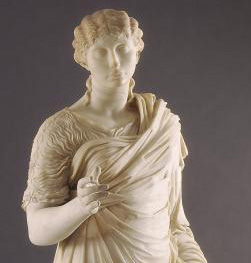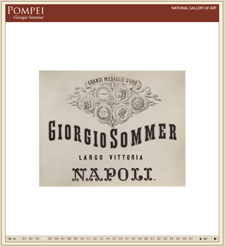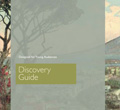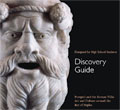![]()
 In the first century BC, the picturesque Bay of Naples became a favorite retreat for vacationing emperors, senators, and other prominent Romans. They built lavish seaside villas in the shadow of Mount Vesuvius where they could indulge in absolute leisure, read and write, exercise, enjoy their gardens and the views, and entertain friends. The artists who flocked to the region to adorn the villas also created paintings, sculptures, and decorative arts for the residents of Pompeii and nearby towns. Pompeii and the Roman Villa presents some 150 works of sculpture, painting, mosaic, and luxury arts, including recent discoveries on view in the U.S. for the first time and celebrated finds from earlier excavations. Exquisite objects from the richly decorated villas reveal the breadth and richness of cultural and artistic life, as well as the influence of classical Greece on Roman art and culture in this region. The exhibition also focuses on the impact that the 18th-century excavations and rediscovery of Pompeii and Herculaneum had on the art and culture of the modern world.
In the first century BC, the picturesque Bay of Naples became a favorite retreat for vacationing emperors, senators, and other prominent Romans. They built lavish seaside villas in the shadow of Mount Vesuvius where they could indulge in absolute leisure, read and write, exercise, enjoy their gardens and the views, and entertain friends. The artists who flocked to the region to adorn the villas also created paintings, sculptures, and decorative arts for the residents of Pompeii and nearby towns. Pompeii and the Roman Villa presents some 150 works of sculpture, painting, mosaic, and luxury arts, including recent discoveries on view in the U.S. for the first time and celebrated finds from earlier excavations. Exquisite objects from the richly decorated villas reveal the breadth and richness of cultural and artistic life, as well as the influence of classical Greece on Roman art and culture in this region. The exhibition also focuses on the impact that the 18th-century excavations and rediscovery of Pompeii and Herculaneum had on the art and culture of the modern world.
Organization
Pompeii and the Roman Villa: Art and Culture around the Bay of Naples is organized by the National Gallery of Art, Washington, in association with the Los Angeles County Museum of Art, with the cooperation of the Direzione Regionale per i Beni Culturali e Paesaggistici della Campania and the Soprintendenza Speciale per i Beni Archeologici di Napoli e Pompei.
Sponsors
The exhibition in Washington is made possible by The Exhibition Circle of the National Gallery of Art.
It is also made possible by Mr. and Mrs. Joe L. Allbritton.
Bank of America is proud to be the national sponsor.
The exhibition in Washington is also supported by The Charles Engelhard Foundation and by Mary and Michael Jaharis.
Additional funding in Washington is provided by Robert and Arlene Kogod, the John J. Medveckis Foundation, and the Malcolm Hewitt Wiener Foundation.
The exhibition is supported by an indemnity from the Federal Council on the Arts and the Humanities.
Lead funding for the catalogue is provided by the Leon Levy Foundation. An additional grant toward the catalogue has been provided courtesy of Rita Venturelli, director, Italian Cultural Institute, Washington, and Francesca Valente, director, Italian Cultural Institute, Los Angeles. We are grateful to the HRH Foundation for supporting the film made on the occasion of the exhibition, and for making possible the exhibition brochure.
Schedule
National Gallery of Art, October 19, 2008–March 22, 2009;
Los Angeles County Museum of Art, May 3–October 4, 2009
Passes
Passes are not required for this exhibition.
Location
The exhibition is on view in the East Building, Mezzanine and Upper Level
Pompeii Film
Pompeii and the Roman Villa: Art and Culture around the Bay of Naples
Narrated by Sir Derek Jacobi and produced by the National Gallery, this
excerpt is from a new documentary film that examines the explosion of
artistic activity around the Bay of Naples beginning in the first century
BC. The film includes original footage of houses in Pompeii and of the
seaside villas that dotted the coastline of the Bay of Naples. The 30-minute
version of the film is on view and for sale at the National Gallery of Art.
The film is made possible by the HRH Foundation.
Highlights from a photographic album of "Pompei," by Giorgio Sommer
 Photographers traveled to Pompeii and other sites around the Bay of Naples soon after the introduction of the medium in 1839. Many of them recognized the potential market for photographs of the ruins as souvenirs for the hoards of tourists that descended on Pompeii during the nineteenth century. Giorgio Sommer (1834–1914) was one of the pioneers who reintroduced antiquity to the world through his work. A native German, he moved to Naples in 1857 to open a studio where he sold photographs of ancient ruins at Pompeii and other sites, ongoing excavations, recovered artifacts, and other images from the Bay of Naples. The following photographs are highlights from Sommer's work in Pompeii and examples of those originally purchased by tourists during their visits to the area.
Photographers traveled to Pompeii and other sites around the Bay of Naples soon after the introduction of the medium in 1839. Many of them recognized the potential market for photographs of the ruins as souvenirs for the hoards of tourists that descended on Pompeii during the nineteenth century. Giorgio Sommer (1834–1914) was one of the pioneers who reintroduced antiquity to the world through his work. A native German, he moved to Naples in 1857 to open a studio where he sold photographs of ancient ruins at Pompeii and other sites, ongoing excavations, recovered artifacts, and other images from the Bay of Naples. The following photographs are highlights from Sommer's work in Pompeii and examples of those originally purchased by tourists during their visits to the area.
View a slideshow of images
Documenting Discovery: The Excavation of Pompeii and Herculaneum
 The ruins of the ancient cities tragically destroyed by the eruption of Mount Vesuvius in AD 79 continue to excite our imagination just as they did when they were rediscovered in the eighteenth century. The finding of such well-preserved examples of ancient civilization helped spark the Enlightenment and an interest throughout the Western world in ancient art and design, classical philosophy and literature. Assembled in the study center of the National Gallery of Art is a selection of works documenting the finds at two of the most important sites: Herculaneum, which was first excavated in 1738, and Pompeii, first excavated in 1748. From books on interior design to collection catalogues depicting artifacts found at the sites, from accounts of the tragedy and studies of daily life in these ancient cities to souvenir photograph books for travelers on their Grand Tour, we present a cross section of the types of works produced from the mid-eighteenth through the nineteenth century. They provide not only a window to the ancient world, but also a view of how those who excavated the sites and evaluated the artifacts saw that ancient world.
The ruins of the ancient cities tragically destroyed by the eruption of Mount Vesuvius in AD 79 continue to excite our imagination just as they did when they were rediscovered in the eighteenth century. The finding of such well-preserved examples of ancient civilization helped spark the Enlightenment and an interest throughout the Western world in ancient art and design, classical philosophy and literature. Assembled in the study center of the National Gallery of Art is a selection of works documenting the finds at two of the most important sites: Herculaneum, which was first excavated in 1738, and Pompeii, first excavated in 1748. From books on interior design to collection catalogues depicting artifacts found at the sites, from accounts of the tragedy and studies of daily life in these ancient cities to souvenir photograph books for travelers on their Grand Tour, we present a cross section of the types of works produced from the mid-eighteenth through the nineteenth century. They provide not only a window to the ancient world, but also a view of how those who excavated the sites and evaluated the artifacts saw that ancient world.
View a slideshow of images
Organization
Organized by the National Gallery of Art, Washington
Schedule
National Gallery of Art, Monday-Friday, October 20, 2008–March 20, 2009
Passes
Passes are not required for this exhibition.
Location
The exhibition is on view in the East Building, Ground Level, Library







